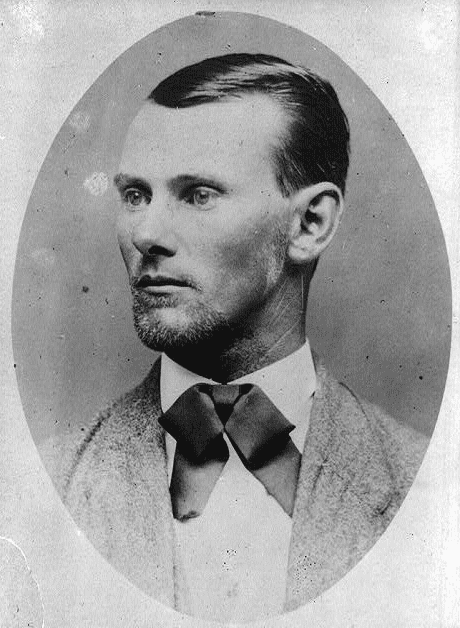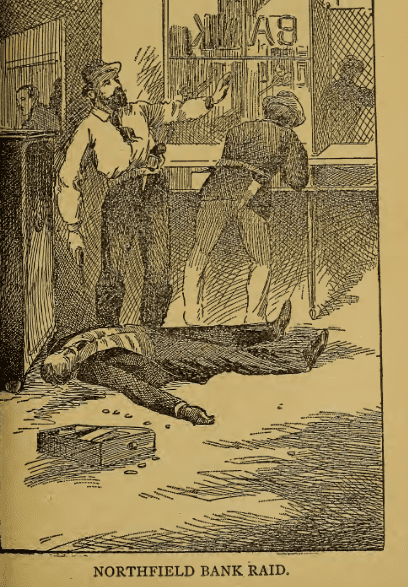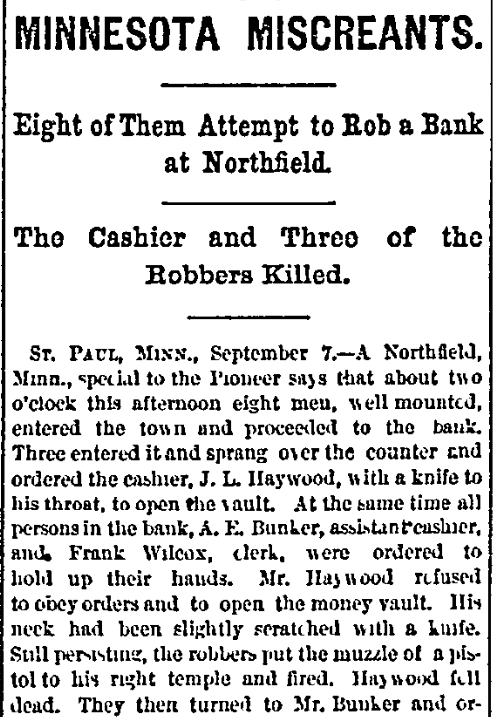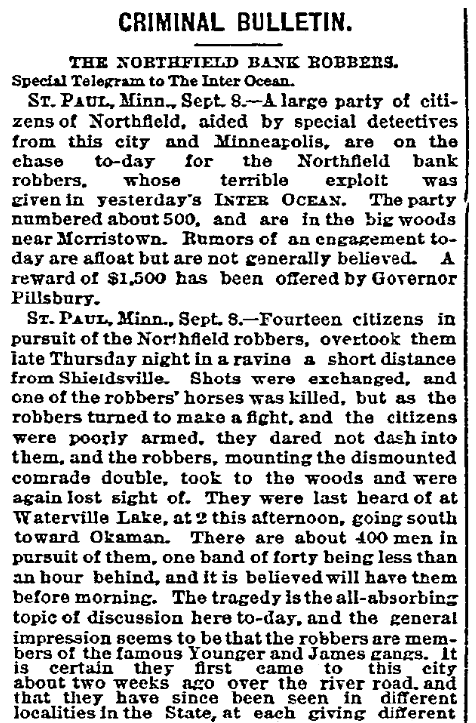From 1868 until the disastrous Minnesota bank robbery in 1876 that broke up the gang, Jesse James rode with a group of former Confederate guerrillas known as the James-Younger Gang, whose core members were brothers: Frank and Jesse James, and Bob, Cole, Jim and John Younger. For nearly eight years the gang experienced remarkable luck. Every bank, train and stagecoach robbery they attempted succeeded, and the brothers who formed the core of the gang always managed to escape capture except for one, John, who was killed.

Then, in the fall of 1876, the Missouri gang decided to range far beyond their accustomed territory, and raided the First National Bank of Northfield, Minnesota, on September 7. It turned out to be a bad decision.

The bank’s cashier was not intimidated and refused to open the vault, despite the knife held to his throat, and the Northfield citizens in the street outside realized a robbery was in progress and began shooting. The fierce gunfire killed two of the outlaws on the spot, and a massive manhunt began for the remaining six as they desperately fled south. The pursuing posse gunned down a third gang member and captured all three Younger brothers. Only the James boys made it back to Missouri, and the band was broken. The James-Younger Gang would never ride again.

One of the civic slogans for Northfield is “Jesse James Slipped Here,” and since 1948 the city has celebrated its citizens’ brave resistance to the James-Younger Gang with a festival called “Defeat of Jesse James Days.” Along with a reenactment of the robbery, the outdoor festival features a parade, carnival, rodeo, and live music.
The following two newspaper articles give details about the Northfield bank robbery and the pursuit of the robbers. Note that the first article, written the day of the robbery, already suspects the James-Younger Gang, commenting: “There are all sorts of rumors as to the robbers, many believing them to be some of the gang heretofore operating in Missouri and Kansas,” while the second article, written the next day, asserts: “The general impression seems to be that the robbers are members of the famous Younger and James gangs.”

Here is a transcription of this article:
MINNESOTA MISCREANTS.
Eight of Them Attempt to Rob a Bank at Northfield.
The Cashier and Three of the Robbers Killed.
ST. PAUL, MINN., September 7. – A Northfield, Minn., special to the Pioneer says that about two o’clock this afternoon eight men, well mounted, entered the town and proceeded to the bank. Three entered it and sprang over the counter and ordered the cashier, J. L. Heywood, with a knife to his throat, to open the vault. At the same time all persons in the bank, A. E. Bunker, assistant cashier, and Frank Wilcox, clerk, were ordered to hold up their hands. Mr. Heywood refused to obey orders and to open the money vault. His neck had been slightly scratched with a knife. Still persisting, the robbers put the muzzle of a pistol to his right temple and fired. Heywood fell dead. They then turned to Mr. Bunker and ordered him to open the vault. He said he did not know the combination. As the robbers made demonstrations toward him he ran out the back door. They fired at him, shooting him through the shoulder. Mr. Wilcox was not interfered with. While this was transpiring within the people of the city without were doing good work. Two of the robbers were killed outright and one wounded. The wounded man was taken away by his confederates. One of their horses was killed and one captured. The citizens of the city behaved like old veterans, as many of them are. The robbers did not get into the vault, nor did they find the Cashier’s drawer, except the nickel drawer, and a handful of nickels taken from it were thrown to the floor. Four of the eight men came to town before midday and waited on the north side of the bridge till the other four came into town from Dundas. The men were well mounted, and armed with navy-revolvers, with cartridges in their belts around their bodies. When the robbers crossed the bridge entering town they drew their revolvers, and, putting their horses into full gallop, dashed through the streets, shouting to the people on the walks to get inside, and ornamenting their shouts with most fiendish curses and imprecations. While the three men were engaged in the bank, the others stood on the street threatening to shoot anyone who interfered, and firing several harmless shots. Pistols and guns were quickly secured by the citizens, and a young man named Wheeler, from a window of the opposite building, picked off one of the villains, shooting him through the heart. Another shot, thought to be from Wheeler, immediately after, prostrated another, when the robbers mounted their horses and beat a retreat. The third robber was hit, but escaped. A band of fifty citizens was organized, and, headed by Wheeler, started in pursuit. At last accounts the robbers were only twenty-five minutes ahead of the pursuers, and are almost sure to be overtaken. There are all sorts of rumors as to the robbers, many believing them to be some of the gang heretofore operating in Missouri and Kansas.

Here is a transcription of this article:
CRIMINAL BULLETIN.
THE NORTHFIELD BANK ROBBERS.
Special telegram to the Inter Ocean.
ST. PAUL, Minn., Sept. 8. – A large party of citizens of Northfield, aided by special detectives from this city and Minneapolis, are on the chase today for the Northfield bank robbers, whose terrible exploit was given in yesterday’s INTER OCEAN. The party numbered about 500, and are in the big woods near Morristown. Rumors of an engagement today are afloat but are not generally believed. A reward of $1,500 has been offered by Governor Pillsbury.
ST. PAUL, Minn., Sept. 8. – Fourteen citizens in pursuit of the Northfield robbers, overtook them late Thursday night in a ravine a short distance from Shieldsville. Shots were exchanged, and one of the robbers’ horses was killed, but as the robbers turned to make a fight, and the citizens were poorly armed, they dared not dash into them, and the robbers, mounting the dismounted comrade double, took to the woods and were again lost sight of. They were last heard of at Waterville Lake, at 2 this afternoon, going south toward Okaman. There are about 400 men in pursuit of them, one band of forty being less than an hour behind, and it is believed will have them before morning. The tragedy is the all-absorbing topic of discussion here today, and the general impression seems to be that the robbers are members of the famous Younger and James gangs. It is certain they first came to this city about two weeks ago over the river road, and that they have since been seen in different localities in the State, at each giving different names and generally different accounts of themselves. In the pocket of one of the robbers killed was found a fine Howard gold watch, a pocket map of Minnesota, a pocket compass, and a small amount of money. In the pocket of the other was a fine gold Waltham watch, but nothing was found on the body either to indicate who they were or where from. Governor Pillsbury has offered a reward of $1,500 for the capture of the robbers, or proportionately for each one captured.
Note: An online collection of newspapers, such as GenealogyBank’s Historical Newspaper Archives, is not only a great way to learn about the lives of your ancestors – the old newspaper articles also help you understand American history and the times your ancestors lived in, and the news they talked about and read in their local papers.

According to a letter written by my great-uncle George Franklin Slosson, world champion billiard player, his father, Stephen Clinton Slosson was Sheriff of Hennepin County near Minnesota, at the time of the Younger and James boys. Can anyone confirm this about my ancestor?
My grandfather, C.M. Barney stayed at a room and board house at this time in Northfield and said he
ate a dinner with many roomers and Jesse James being one of them. My grandfather said it was very quiet during dinner. When James left someone said who was that guy, and someone else spoke up and
said Jesse James. A lot of jaws obviously dropped at that time. My grandfather was a nursery salesman,
and traveled throughout taking orders for future delivery.
It is said that one of my great grandfathers was an engineer of a train that the James gang robbed, but no further information is known at this time.
Well then, you have a direct connection to this story, Dawn! Thanks for writing us.